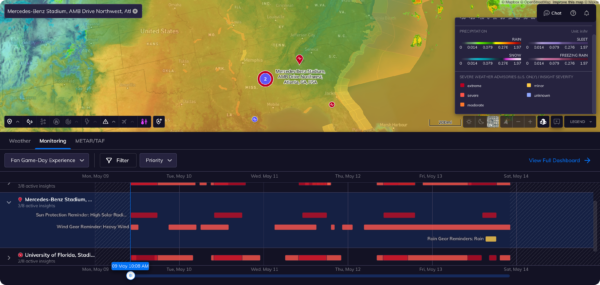Heat Illness Safety
Heat cramps, exhaustion, and dehydration are common heat-related illnesses that impact athletes each summer. Prevent heat-related illnesses by providing adequate training guidance and managing the intensity of exercise depending on the temperature.
More than 100,000 student-athletes require medical attention due to heat-related illnesses each summer, causing them to miss numerous practices and games.
Stadium/Field A
Court/Course/Resort B
Insight In this Dashboard
severity - 4 extreme
Increase Hydration: Prolonged Heat
For every hour of exercise outside in these temperatures, athletes should break for an eight-ounce cup of water every 20 minutes.
severity - 4 extreme
Prohibit Outdoor Exercise: Extreme Heat
The temperature outside is higher than that of the skin, making it hard for the body to release heat. Exercise should be discontinued until temperatures decrease.
severity - 1 minor
Train With Caution: Low Heat Risk
Practice with caution and discretion. Be on the lookout for signs of heatstroke. Keep athlete hydrated by replenishing lost body fluids frequently throughout practice. Provide 3 rest breaks each hour with a minimum duration of 4 minutes.
severity - 2 moderate
Ensure Appropriate Hydration: Low Heat Risk
Heatstroke risk is relatively low; however, athletes must remain adequately hydrated. Provide at least 3 rest breaks every hour for a minimum duration of 3 minutes.
severity - 3 sever
Increase Breaks: Moderate Heat Risk
The danger of heat illness greatly increases during these temperatures. Do not practice for more than 2 hours at a time. Limit sports clothing and accessories as much as possible. Give athletes a 4-minute break for every 30 minutes of heavy exercise, or every hour of medium exercise. For every 3 cups of water drink 2 cups of sport drinks to replace electrolytes and salt that are lost from sweat.
severity - 3 sever
Limit Heavy Exercise: Severe Heat Risk
There is a high risk of heatstroke. Limit practice time to one hour maximum. Avoid strenuous outdoor exercise that will increase body temperatures. Move physical exercise activities indoors to a cooler environment if possible. Ensure a 20 minute rest break is provided every hour. For every 3 cups of water drink 2 cups of sport drinks to replace electrolytes and salt that are lost from sweat.

